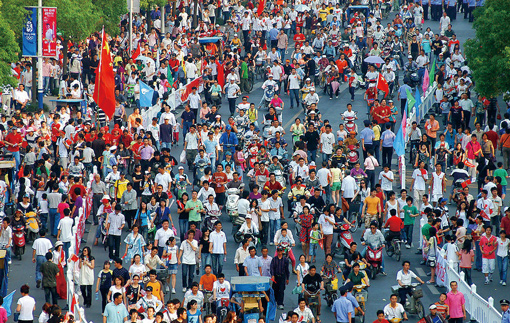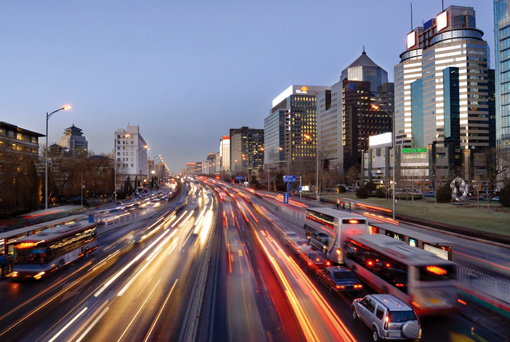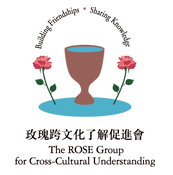China’s Reawakening
By Bates Gill
China’s impact
 China’s numbers tell a dramatic story: world’s
largest population, fastest growing economy over the past 30 years, largest number of cellphone users, largest number of Internet users, largest emitter of greenhouse gases, largest currency reserves, largest standing army, largest importer of iron ore, aluminum, and paper, second largest consumer of oil, third largest economy, and 200 million persons lifted from poverty in the past 20 years. Moreover, China’s spectacular growth is historically unprecedented in its scale and intensity and represents one of the most remarkable socioeconomic transformations in history.
But think also what this means for China’s neighbors and for the world.
In a globalized world what happens in China affects us everyday: our common concerns include global warming, alternative energy sources, the global telecommunications revolution, nuclear proliferation, human rights, peace in Darfur. No solution to these challenges will work without China on board. But it is not only on such “big issues” that China matters. Think of matters—especially important to young people—like the cost of an iPod, or a car, or a gallon of gas, the availability of good jobs, competition for college admissions, and what is on the Internet—these and many more aspects of daily life will all be increasingly affected by China’s growing influence.
China presents the world with huge challenges and possibly even larger opportunities. But are we ready to meet those challenges and make the most of those opportunities?
Unfortunately, the answer today is probably not—or certainly not as much as we should. Given the enormous importance of China, it is remarkable how poorly Americans understand the country, its people, and its impact. True, there may be no way to fully “understand” a country with a territorial expanse about equal to the United States, with 1.3 billion persons, and with 4,000 years of recorded history. But today the stakes are too high for Americans to treat China as if it were “just” another important country on a par with many others. U.S.-China relations are already today the single most important bilateral relationship in the world among the major powers. As such, Americans—and especially the next generation of leaders—have much to do in order to dispel myths and confusion about China and gain far greater awareness, knowledge, and foresight about this emerging superpower. We might begin by thinking and learning about China’s past, present, and future.
China’s past
Of course, to talk about “China’s emergence” is not really accurate. What we are witnessing today is actually China’s re-emergence as a Great Power. China has been for the vast majority of its history one of the most important countries on Earth. The political, economic and military reach of the Chinese empire, at its peak during the mid-Ming dynasty, stretched across Asia, and included the epochal voyages of the Chinese admiral Zheng He, whose massive fleets reached the shores of east Africa in the early-1400s—a century before the great age of European maritime discovery. Moreover, Chinese culture and invention made enormous contributions to the human civilization: inventions such as paper, the printing press, the magnetic compass, gunpowder, iron-chain suspension bridges, the seismograph, porcelain, oil lamps, and crop rotation, to name but a few.
It is important to look to China’s past because this history deeply shapes Chinese thinking about the country’s proper place in the world today and in the future. Chinese are deeply proud of their civilization, of their country’s historical greatness and status as a powerful and influential country for much of recorded human history. Chinese history books today painfully document the period between mid-19th and mid-20th centuries as the “hundred years of shame” – a time when the greatness of imperial China was destroyed by domestic decay, foreign exploitation, occupation, and invasion, and bitter civil war. Chinese leaders today aim to keep the country on a course which casts off the historical memories of weakness and chaos, and reestablishes China to its “rightful place” as one of the world’s most powerful, prosperous and respected nations.
In short, a deeper understanding of China should begin with an appreciation of its past and what that past tells us about the country’s aspirations for the future.
China’s present
Today, even as the Chinese pursue a path to reclaim China’s past prominence, they understandably aspire to a better life for themselves and their families. The leadership of China—the Chinese Communist Party—understands this, and knows that their ability to maintain one-party rule depends very heavily on continued economic growth and hence improvement in the daily lives of the Chinese people. But here is the dilemma: the very process of rapid economic growth generates new and difficult social, economic, and political problems.
For example, average per capita income in China is steadily on the rise, but wealth is concentrating in fewer and fewer hands, meaning a widening gap between the rich and the poor. Standards of living are rising for most Chinese, but that means increasing pressure on scarce natural resources such as energy, water, and land. China is becoming more industrialized and urbanized, but at an extremely high cost to the local environment and the health of its citizens. Just one remarkable statistic says so much: everyday in Beijing—not even the largest city in China—some 1,500 new cars are registered, amounting to more than half a million new vehicles a year on the streets of the capital. Not surprisingly, Chinese cities are among the most congested and polluted on Earth, and China has the highest rate of traffic fatalities in the world.
With more wealth in China, opportunities for corruption increase, especially as local officials take unfair advantage of their positions of power. People are in general “better off” today in China, but for the growing numbers of those left behind by socioeconomic change, there is an increase in alienation, disgruntlement and anger, resulting in a rising incidence of crime, social unrest, civil disturbances, and rioting in many parts of the country. China has seen many benefits from globalization, but its deepening dependence on global markets means the world economic downturn hits China all that much harder.

Americans need to understand these developments in China today so we can be realistic about what we can ask China to do as a partner in world affairs. Asking China to “slow down” or put off its development will not be acceptable to either the Chinese leadership or its people. On the other hand, they will be more open to good ideas which help them find the right balance between prosperity and sustainability. The smart people who figure out that balance—through the intelligent application of policy, investment, and technology—will be in much demand. They will not only help China through a difficult transition period—they will help achieve a more stable and sustainable world for the future as well.
China’s future
It is difficult to predict the precise course China will take in the coming decades. Clearly the China of tomorrow will have an enormous impact on the lives of Americans. We all need a far better understanding of China.
China faces some daunting challenges. Simply assuring that its enormous population is relatively stable, fed, and sheltered is a critical need that cannot be met by domestic resources alone. In continuing its expansive search abroad for natural resources, technologies, and investments, there will be an increase in competition with the U.S. and others. The question arises whether this competition will be virtuous—where the parties push one another toward positive and even cooperative solutions—or vicious—where they instead turn to contention and even conflict.
But other challenges loom for China at home as well. Its major cities are among the most polluted in the world and this problem is only getting worse. China’s healthcare system is deteriorating, especially in the countryside where some 60 or 65 percent of Chinese live. Diseases such as tuberculosis and HIV are on the rise. The population is rapidly aging. By 2040 some 400 million persons—far more than the current population of the United States—will be over the age of 60. Yet the country has no viable social security or retirement pension system to help care for that population. The country continues to grapple with significant separatist movements in its vast western territories such as in Tibet and Xinjiang, and a long-term solution to its differences with the island of Taiwan—which is politically separate from China but which Beijing claims is under Chinese sovereignty—remains elusive. And we must ask—how long can the current one-party political system last in the face of the country’s spectacular social and economic changes and challenges?
Americans need to think hard about China’s future. It is in American interests to see a China which is more stable, more open, more prosperous, more globally cooperative and engaged, and more sustainable than it is today. There are also implications for all of Asia and, indeed, for the planet. Americans surely do not have an interest in a future China which is riddled with unrest, more authoritarian, economically weak, insecure about its foreign relationships, and more environmentally scarred.
A China under the second scenario would be a world-wide problem. On the other hand, those who think about and help realize the first scenario—of a more stable, open, prosperous, cooperative and sustainable China—will make a critical contribution to improving the world, improving U.S.-China relations, and making our lives better in many ways.
Next step
You have heard the Chinese saying, “Even a journey of a thousand miles begins with one step.” So it holds for thinking and learning about China: it may seem daunting at first, but it is surely important to start. There will be enormous demand in America for many, many experts who understand China, become fluent in Chinese, and learn more about the country.
At the least, all of us must become smarter about China, no matter what our careers may be, from archeology to zoology, from energy to public health. Regardless what future calling young people today may choose, they will need to take the time to learn more about China—its past, present, and future—and what it means for them.
Bates Gill, Director of the Stockholm International Peace Research Institute (SIPRI), an independent think-tank focusing on bettering the conditions for a more stable and secure world, held the position of the Freeman Chair in China Studies at the Center for Strategic and International Studies (CSIS) in Washington, D.C and was the inaugural director of the Center for Northeast Asian Policy Studies at the Brookings Institution. He has more than 125 publications to his credit.
Bates Gill is the author, co-author, or co-editor of six books, including Asia’s New Multilateralism (with Michael Green)(Columbia University Press, forthcoming in 2009), Rising Star: China’s New Security Diplomacy (Brookings, 2007), as well as China: The Balance Sheet: What the World Needs to Know Now About the Emerging Superpower (Public Affairs, 2006), Weathering the Storm: Taiwan, Its Neighbors, and the Asian Financial Crisis (Brookings, 2000), Chinese Arms Acquisitions from Abroad (Oxford, 1994), Arms Trade Transparency in Southeast Asia (Oxford, 1996), and Chinese Arms Transfers (Praeger, 1991). |
|



